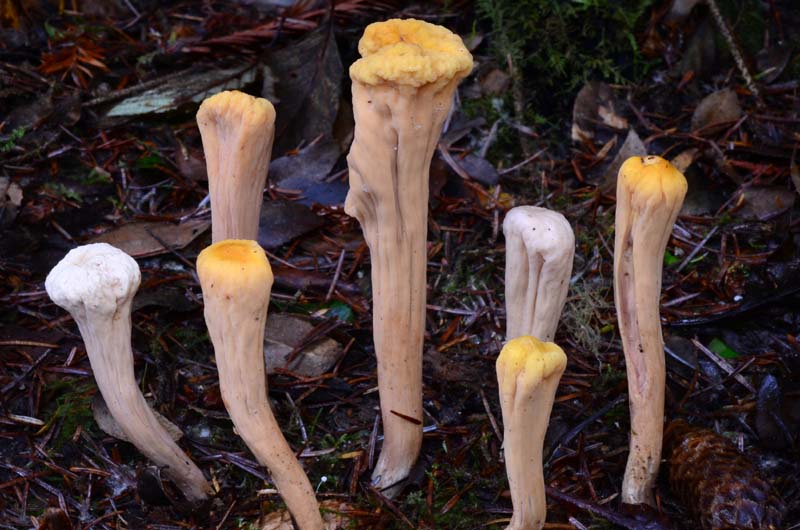
© Noah Siegel
Danny’s DNA Discoveries – Clavariadelphus of the PNW
by Danny Miller
Click here for my Pictorial Key to Clavariadelphus.
|
|
Danny’s DNA Discoveries – Clavariadelphus of the PNW
Click here for my Pictorial Key to Clavariadelphus. |
|
Introduction
Clavariadelphus are tough club-shaped mushrooms usually with a fertile wrinkled stem. Like most other Basidiomycota clubs, they do not have a truly differentiated head and they are not covered in pimples. However, the head can sometimes be expanded and/or flattened enough to make someone mistake one for a chanterelle or Turbinellus false chanterelle (with a scaly, indented cap). This genus is a mess. There is not yet any rhyme or reason to the names placed on the collections and what the sequence ends up saying about the species. We're probably going to need type sequences to sort this out. And it's even possible Clavariadelphus will need to be split as my tree doesn't show them altogether in the same clade (or perhaps many things will have to be combined into it). As a matter of fact, the entire Gomphales order is a mess. It is possible that the corals in Ramaria subgenus Lentoramaria will have to be split into 4 cryptic genera, or else some of them might have to be moved inside the club genus Clavariadelphus along with our species of Lentaria. A multi-gene study is going to be needed and some tough choices might have to be made. abundant common uncommon rare - colour codes match my Pictorial Key and are my opinions and probably reflect my bias of living in W WA. Rare species may be locally common in certain places at certain times. |
|
Summary of Interesting Results
Here are some of the newest, most interesting results of the study:
|
|
Clavariadelphus
The genetic picture of this genus is pretty unclear. The same sequence may have multiple species names attached to it, and for those species with more than one sequence available, the sequences are usually quite different. We're probably going to need type sequences to sort this out. Here are the genetic species known from the PNW: Clavariadelphus ligula EU - cylindric to flattened, two PNW sequences are 3 bp different in ITS from a half dozen or so EU type area sequences. Clavariadelphus sachalinensis Russia - differentiated microscopically from C. ligula. A few OR and BC sequences match one possible Russian type area sequence. These two sequences don't always clade with the others in an ITS tree, but I'm not terribly worried about that for now. Clavariadelphus 'truncatus PNW02' (C. truncatus EU misapplied?) - differs from some type area sequences of C. truncatus EU mostly in ITS2, although overall closer to C. aurantiacus China. It can be quite a large species with a flattened head and may be what we have been calling C. truncatus. We need a type sequence and a study to see if this species really differs from it. A test on a dried specimen suggests that this species turns red in KOH like C. truncatus is reported to. Clavariadelphus ligula © Autumn Anglin and Danny Miller, C. sachalinensis © Jenny Lippert, C. 'truncatus PNW02' © Drew Henderson
Clavariadelphus PNW01 - variously identified as C. truncatus, C. occidentalis, and C. subfastigiatus. Clavariadelphus PNW03 - sometimes identified as Clavariadelphus occidentalis CA, but a few other genetic species have been identified as that too. One collection was white (perhaps it was young and the spores hadn't matured). Clavariadelphus PNW01 © Jenny Lippert, Clavariadelphus PNW03 © NAMA and the Field Museum of Natural History, and Michael Beug
Clavariadelphus PNW04 - variously identified from several OR collections as C. caespitous, C. occidentalis, and C. subfastigiatus. Clavariadelphus caespitosus seems plausible, as it is a somewhat unique, clustered pinkish species with a unique shape as well, and that matches our one known photo. Clavariadelphus PNW07 - another candidate for being Clavaridelphus caespitosus, based on our one known photo, although it has also been collected as C. mucronatus, C. occidentalis, and C. ligula in OR. Clavariadelphus PNW04 © NAMA and the Field Museum of Natural History, Clavariadelphus PNW07 © Bruce Newhouse
Clavariadelphus PNW05 - our one WA collection resembled C. truncatus and another C. pallidoincarnatus CA, with a somewhat flattened head. Clavariadelphus PNW06 - one OR and one northern BC collection, collected as C. truncatus, but not resembling that species in our one photo. Clavariadelphus PNW05 © Eric Chandler, Clavariadelphus PNW06 © Bruce Newhouse
Clavariadelphus mucronatus AK - whitish with a sharp, papillate umbo. BC, WA, AZ, and EU sequences probably represent this unique looking species. Clavariadelphus subfastigiatus OR - described locally so it must be here. KOH turns green. No reliable sequences yet. Clavariadelphus PNW08 - known from one OR sequence, identified as C. truncatus. Clavariadelphus PNW09 - known from one OR sequence, identified as C. occidentalis. Clavariadelphus PNW10 - known from two OR sequences, and one CA collection, identified as C. occidentalis. Clavariadelphus PNW11 - known from one OR sequence, identified as C. occidentalis. Clavariadelphus mucronatus © Terri Clements and Donna Fulton, C. PNW10 (from CA) © Dean Lyons
Other species reported from the PNW: Clavariadelphus occidentalis CA - fairly nondescript, this will have be recognized microscopically, or better yet by a type sequence. Clavariadelphus caespitosus TN - pinkish and clustered, with unusually shaped fruit bodies. if this is not PNW04 nor PNW07, we need to figure out what it is. Clavariadelphus pallidoincarnatus CA - a somewhat flattened head like C. truncatus, but a smaller species. If this is not PNW05, we need to figure out what it is. |